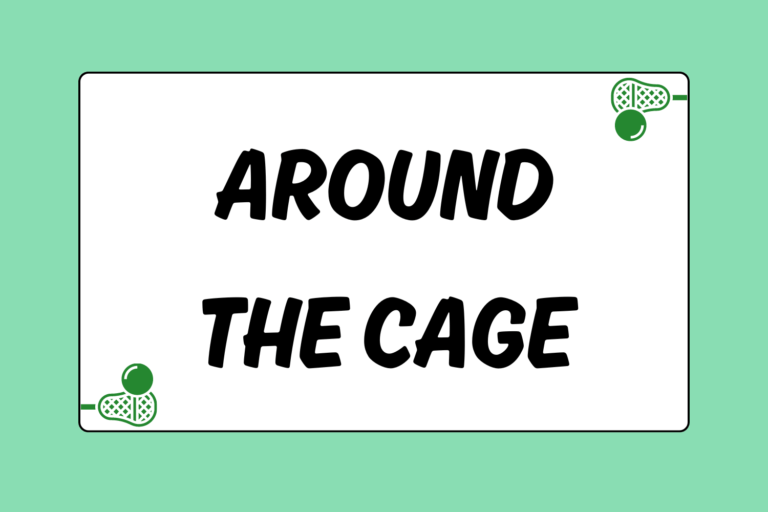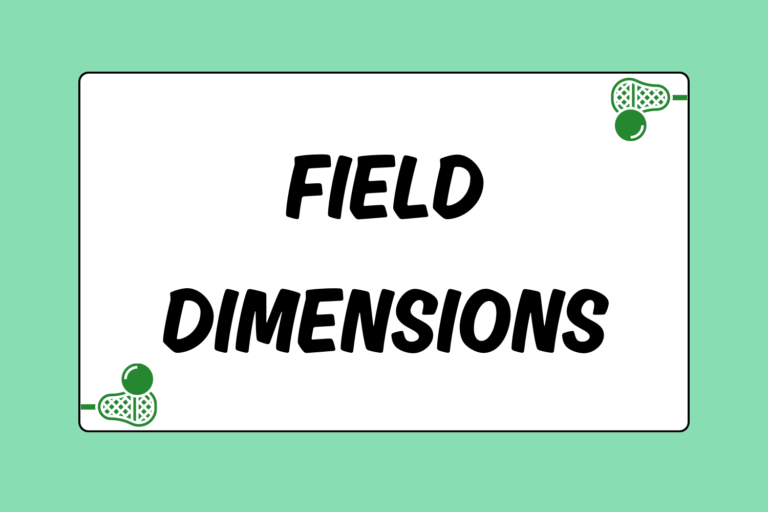Every team has its strengths and weaknesses offensively. The coach’s job is to figure out what these are, and put his players into situations where they are most likely to be successful on the field. One way to do this is by utilizing different offensive formations.
There are various offensive formations that teams will use to maximize their talent on the field. All formations involve three attackmen and three midfielders working cohesively to space the field and find good shooting opportunities.
When formations are listed in number form, assume all players are in the restraining box:
- The first number represents players closest to the restraining line.
- The second number represents those players on the crease or goal line extended (GLE).
- The third number represents players located below GLE.
2-3-1
The 2-3-1 (sometimes referred to as 23) operates with two triangles of players, moving in sync with one another. The triangles should be in constant motion. Two midfielders are just inside the restraining line up top, three players are along GLE or on the crease, and one attackman operates behind the cage at X. The 23 set is normally a “motion�? offense, where players are constantly attempting to get open on cuts and keep the defense off-balance.
The 23 requires midfielders who are quick and can finish around the cage, and attackmen that are excellent feeders from X and on the wing.
Two midfielders are near the top of the restraining box, with the third midfielder playing on the crease. These three players form a triangle, and should all be able to play on the crease. When one of the high mids cuts to the crease, the other high mid should fill the space the cutter was originally occupying. The third midfielder, who was originally on the crease, will bump up and replace the top midfielder who has moved over.
In the attack triangle, one player is at X, with one player on each wing (on GLE). The attack rotation out of this formation is initiated when the ball works around to the X attackman. The adjacent wing player will cut across the front of the cage and over to the other wing, freeing up the X-man to drive to the vacated area where the wing attackman cut from. The driver at X starts his move as soon as the wing player has begun his cut. The high midfielder on the side where the attackman is driving will then cut down to the crease, anticipating a pass from the driving attackman, as the crease midfielder rotates up top. Both triangles should be rotating at the same time for maximum efficiency.
3-1-2
This offense is similar to the 2-3-1, but with slightly misshapen triangles and an attackman on the crease. The three midfielders are all up top near the restraining line, while the attackmen form a triangle with one on the crease and the other two behind GLE on opposite sides of the cage. With two attackmen operating behind the goal, there is a ton of space for the other four offensive players to work above the cage, as well as plenty of room for the two attackmen behind the cage to play the two-man game.
To effectively run the 3-1-2 (also known as the 31), a team needs to have attackmen that are strong passers, finishers, or both. The midfielders must be strong drivers and cutters, and should be able to effectively shoot on the run.
A play is normally initiated in this formation with the center midfielder up top. One of the adjacent midfielders will cut across and in front of the center mid to the other side, and the ball carrier will begin a strong move to the vacated space where the cutter came from. The cutter has the option to set a pick for the center midfielder on his way over.
At this point, the attackmen should also begin a rotation. The low attackman on the side where the midfielder is driving should cut up to the crease or float up from GLE to a shooting position, while the attackman who was on the crease to begin the play cuts back behind the cage opposite the side where the midfielder is driving. The third attackman then replaces the first cutter who went to the crease.
As with the 2-3-1, when someone cuts, it is the responsibility of the other players in his triangle to rotate and replace at the right time.
2-2-2
The 2-2-2, or the 22 as it is sometimes known, is an offense that relies mostly on crease play, whereas the previous two were more about motion and dodging. The perimeter players in the 2-2-2 form a square around the cage, with two midfielders spread out up top just inside the restraining line, and two attackmen behind GLE on either side of the goal.
On the crease are a midfielder and an attackman, working together to set picks and cut to get open around the goal for feeds from the perimeter players. Everything that happens in the 22 offense is predicated on the creasemen working together to get open.
In the 22, the team needs a good crease attackman, someone who can catch anything around the goal and finish accurately. The high midfielders should be good passers, able to fit the ball into a tight space while being pressured defensively. The midfielder playing the crease should be adept at picking and should have a good sense for exactly where he is on the field. Spacing is crucial in the 22 set.
Players on the perimeter work the ball around the outside quickly, while the two crease players pick and re-pick for each other, trying to time their cuts to get open in a good spot for the ball carrier to feed them near the cage for a quick shot. There are driving opportunities for the perimeter players out of the 22, but they are more difficult to convert since the crease area is more crowded.
1-4-1
The 1-4-1 (or 14) is basically a modified 2-2-2, with the perimeter players forming a diamond shape around the cage instead of the square used in the 22. The main difference is that the 14 is more used to create driving opportunities, whereas the 22 is mostly about crease play. Teams often will shift mid-play from a 22 to a 14.
The 14 requires strong dodgers and finishers. An attackman or midfielder that can drive and shoot with his left hand makes this formation much easier to execute.
In 14, a strong driving midfielder will play alone up top around the restraining line. Down on the wings are a midfielder and an attackman, one of whom hopefully has a strong left hand and can drive from the right side. An attackman and midfielder share crease duties. The creasemen need to be more spread out than in the 22, since a midfielder will often be driving from up top, and needs feeding options once the crease defenders commit to a slide. Lastly, an attackman plays at X and looks primarily to feed or get open on sneaks near the crease, while the high midfielder is driving to the cage.
Zero
“Zero” actually refers to a few different offensive sets with one common factor. Zero means there are literally zero players on the crease, leaving the middle of the field in front of the goal open for cutters and drives. Often a team will open up a possession in the zero set, and then move into another set in order to confuse defenses about slide responsibilities. However, some teams like to run plays or even full possessions out of the zero.
A team with a lot of good drivers or cutters may employ the zero set. This set is also effective for the man-up unit, since the defense will usually play one man in the crease area, regardless of whether an offensive player is in that position.
In the zero, probably the most important assets for players to have are tenacity and intelligence. The tenacity comes into play when cutting and moving on the field, and keeping the defense off-balance and hopefully confused. Intelligence is a factor in knowing when to pass to a cutter, or when to hold the ball and be patient.
Some possible alignments out of the zero include:
- 3-2-1: Three mids up top along the restraining line, two attackmen on the wings on GLE, and one attackman playing behind the cage at X.
- 2-2-2: Two mids about 5 to 10 yards apart up top at the restraining line, one mid wide in the area between the wing and restraining line, one attackman opposite the low mid, and two attackmen operating behind the cage below GLE. The end result is a hexagon-shaped formation around the goal.
Backdoor cutters are the name of the game with the zero sets. Since man-to-man defenses cannot slide from the crease, they are forced to slide adjacently. In addition to having the area in front of the cage open for cutters to catch feeds, defenses are more apt to lose track of a cutter when sliding adjacently, since they are generally more focused on where they need to be in the defensive rotation.
As with any other set, initiating offense in the zero starts with an effective dodge and drive towards the cage, forcing the defense to adjust and start their rotation. Offensive players must be prepared to move into open spaces left vacant by sliding defenders, and be able to catch passes while on the run, so that the defense doesn’t have time to recover.
Hot Tip: Zero Tolerance
If you’re playing a team who likes to aggressively double-team ball carriers, run the zero set. You will know exactly where a slide is coming from, and there will be a ton of space for off-ball cutters to get open around the cage and exploit the defense’s aggression.
Pick Your Poison
All different styles of offense can be effective if executed correctly and intelligently. A sampling of college games will give you a good idea of the different styles and how they enable teams to control the flow and pace of a game. While some may not be as fun as others to watch, sometimes the more methodical and “boring” offenses are the ones that end up winning championships.





